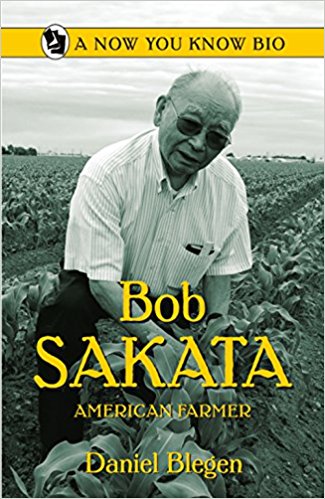Bob Sakata: American Farmer (book)
Creators: Daniel Blegen
Biography for children by Daniel Blegen about a Nisei farmer in Colorado that covers his wartime incarceration in an American concentration camp.
Synopsis and Background
The book's nine chapters cover Sakata's life in chronological fashion. The first three chapters cover his father's childhood in Kyūshū and migration to the U.S. in 1902; establishing a family farm in Centerville, California, where Bob, the youngest of four children, was born; and Bob's early life amid poverty. The next five chapters largely focus on the war years and aftermath, covering the family's forcible removal and incarceration at Tanforan and Topaz , Bob's resettlement in Brighton, Colorado, at the end of 1942, and the entire family's ultimate settlement there after the war. The last two chapters briefly cover the postwar years and Sakata's ultimate success as a farmer despite serious injury and personal tragedy, culminating with a visit from Emperor Akihito to the Sakata farm in 1994. To buttress Sakata's reminiscence of the war years, Blegen also relies on many excerpts from Yoshiko Uchida 's Journey to Topaz . The book is illustrated with archival photographs—many by Dorothea Lange —and includes a timeline, glossary, sources, index, and acknowledgments, as well as Sakata's "Philosophy of Life."
Author Blegen was a longtime schoolteacher in Brighton who met Sakata in 1975, when Sakata was president of the local school board and Blegen was a new hire. Bob Sakata: American Farmer was his second book for children. Blegen is also a musical performer who has done one-man theatrical performances based on the lives of Woody Guthrie and Pete Seeger. He works out of Longmont, Colorado. Bob Sakata: American Farmer is one of seventeen books in Filter Press's "Now You Know Bio" series. Filter Press also has a bilingual "Great Lives in Colorado History" series that includes books on journalist Bill Hosokawa and wartime Colorado Governor Ralph Carr . All books in both series profile prominent people in Colorado history.
Historical Accuracy
There are many mostly minor errors in Bob Sakata: American Farmer . Blegen writes that "Emperor Taishō" was emperor during Bob's father's childhood in Japan (page 7); however the Taishō emperor's reign didn't begin until 1912, at which point Bob's father had been in the U.S. for a decade and was twenty-eight years old. "The first Japanese immigrants had settled in California, Oregon, and Washington early in the 1800s." (30) Barred from traveling abroad until the end of the Tokugawa era in Japan in 1867, the first migrants to the U.S. didn't arrive until after that and didn't arrive in significant numbers until the 1890s. "The Oriental Exclusion Act of 1907 even barred Asian immigrants from becoming citizens." (30) The author is likely conflating the Gentlemen's Agreement of 1907–08 that ended the migration of Japanese laborers to the U.S. with the Immigration Act of 1924 , which ended all Japanese immigration to the U.S. The ban on Asian immigrants becoming naturalized American citizens stems from 1870 legislation and was definitively determined by the 1922 Ozawa Supreme Court decision .
In describing the run up to Executive Order 9066 , Blegen quotes from the Munson Report (without naming it) and claims it came from "the State Department" (33); the Munson Report was a product of a secret intelligence operation based in the White House. A claim that Executive Order 9066 ordered the removal of "both 'aliens' and 'non-aliens'.... all Japanese Americans would be forced out of California, Oregon, and Washington." (34) Here, the author seems to conflate EO9066 with the later civilian exclusion orders where the "non-alien" terminology appears. While the exclusion orders did force all Japanese Americans out of California, those in the eastern portions of Oregon and Washington were spared. Japanese Americans in the southern part of Arizona were also removed. A claim that 10,000 Japanese American left the West Coast during the " voluntary evacuation " period (35); the actual figure is closer to 5,000. "Nearly 110,000 Japanese Americans were taken to the temporary assembly centers throughout California, Oregon, and Washington." (49) Over 25,000 of the evicted Japanese Americans did not go to " assembly centers ," instead going directly to Poston (about 11,000), Manzanar (10,000), Tule Lake (3,000), and Gila River (3,000). The number who did go to assembly centers is thus in the low 80,000s. There was also an assembly center, Mayer , in Arizona. In the chapter on life in the concentration camps, the author suggests that inmates set up and ran the schools and quotes Sakata as saying that the "government 'did nothing' about providing education" (57); the federal agency running the camps, the War Relocation Authority , did operate K–12 schools in all of the camps it ran, hiring teachers from both inside and outside the camps.
Might also like When Justice Failed: The Fred Korematsu Story by Steven A. Chin; The Japanese American Internment: An Interactive History Adventure by Rachael Hanel; Lucky Ears: The True Story of Ben Kuroki, World War II Hero by Jean A. Lukesh
| Author | Daniel Blegen |
|---|---|
| Pages | 100 |
| Publication Date | 2009 |
For More Information
Publisher website: http://www.fieldmousebooks.com/index.php .
Author website: http://www.danielblegen.com/ .
